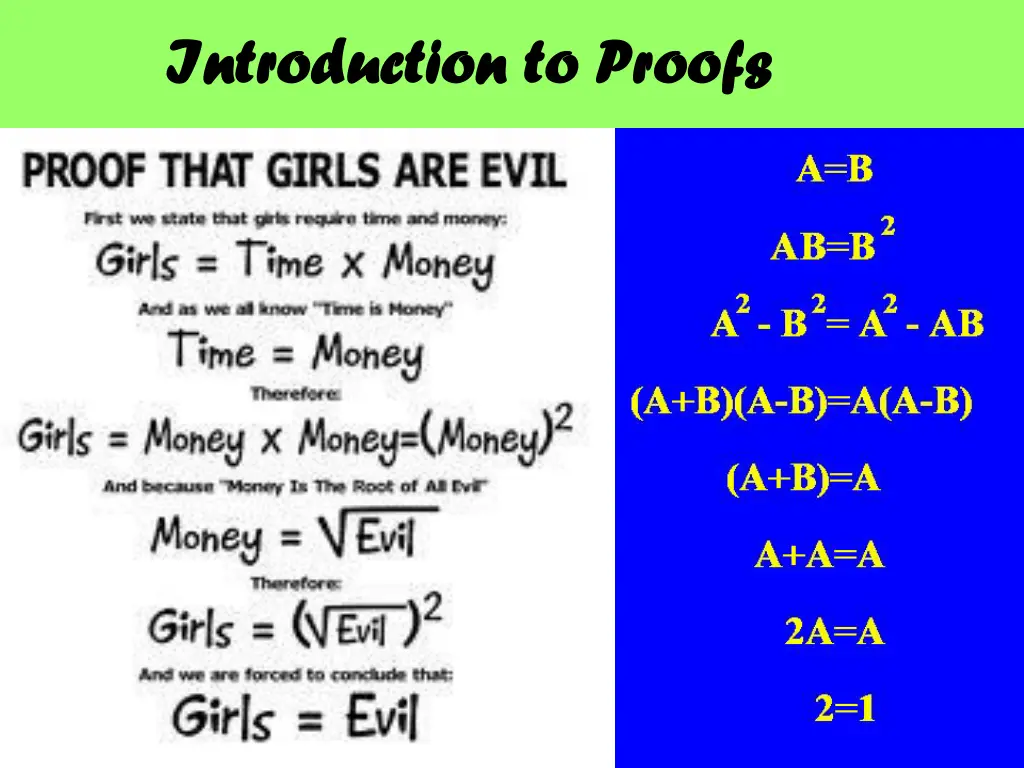
Introduction to Proofs and Reasoning in Mathematics
Explore the use of reasoning and logic in mathematical proofs, including inductive and deductive reasoning, different proof strategies such as direct proof and proof by contradiction, as well as if and only if proofs. Discover the fundamentals of two-column proofs and how to apply them in mathematical arguments.
Download Presentation

Please find below an Image/Link to download the presentation.
The content on the website is provided AS IS for your information and personal use only. It may not be sold, licensed, or shared on other websites without obtaining consent from the author. If you encounter any issues during the download, it is possible that the publisher has removed the file from their server.
You are allowed to download the files provided on this website for personal or commercial use, subject to the condition that they are used lawfully. All files are the property of their respective owners.
The content on the website is provided AS IS for your information and personal use only. It may not be sold, licensed, or shared on other websites without obtaining consent from the author.
E N D
Presentation Transcript
Introduction to Proofs Introduction to Proofs
The use of Reasoning and Logic in proofs Inductive Reasoning- reasoning from detailed facts to general principles Specific examples and assumes it generally Deductive Reasoning- reasoning from the general to the particular Generally prove topic, examples come after Logic- a system or mode of reasoning; the formal, guiding principles of a discipline. If p then q, p if and only if q, etc. Definitions from www.thefreedictionary.com
Some Types/Strategies of Proofs Direct Proof Proof by Contradiction Proof by Contrapositive If, and Only If Mathematical Induction Proof by Exhaustion Proof by Enumeration The Pigeon hole Principle Counterexamples
Direct Proof If P, then Q. This is a paragraph proof version of the two- column proof. Direct proofs start with the hypothesis (assume it s true), of a statement and deduce that the conclusion is true through a series of direct steps. -Those steps use definitions, theorems, axioms, etc.
Proof by Contradiction This type of proof is meant to prove a proposition is either true or false and not both true and false (that is where the contradiction lies). In other words, assume P and not Q then prove the contradiction. Need to mention somewhere in the proof that there is a contradiction with what was assumed.
If and only If Proofs Need to prove: P if and only if Q. In other words, prove if P then Q and if Q then P. Assume the hypothesis is true and prove the conclusion, then assume the conclusion is true and prove the hypothesis is true.
Proof by Contrapositive P implies Q and Not Q implies not P Example: If it is my toothbrush, then it is purple. is equivalent to If it is not purple, then it is not my toothbrush. Assume the conclusion is not true, and then prove the hypothesis is not true also.
Proof by Induction Base Case Assume P(K) then prove P(k+1). The stair analysis.
Bertrand Russell said Pure mathematics consists entirely of such asseverations as that, if such and such a proposition is true of anything, then such and such another proposition is true of that thing... It's essential not to discuss whether the proposition is really true, and not to mention what the anything is of which it is supposed to be true... If our hypothesis is about anything and not about some one or more particular things, then our deductions constitute mathematics. Thus mathematics may be defined as the subject in which we never know what we are talking about, nor whether what we are saying is true.
References http://www.tumblr.com/tagged/proof-that-girls-are-evil A=B proof picture http://zimmer.csufresno.edu/~larryc/proofs/proofs.html www.thefreedictionary.com Two-column proof image http://www.personal.kent.edu http://www-cs-students.stanford.edu Logic Table Image Image of Proof by Contradiction Image for Induction proof http://www.purplemath.com/modules/inductn3.htm
